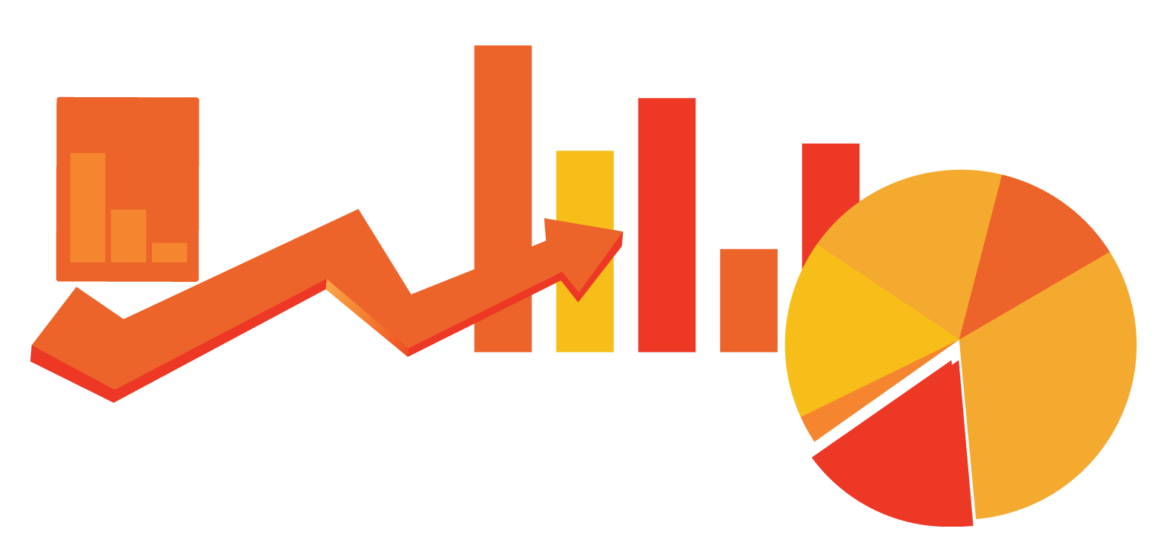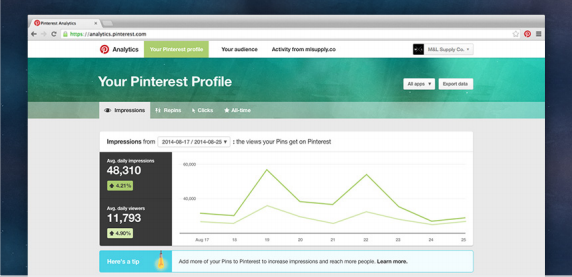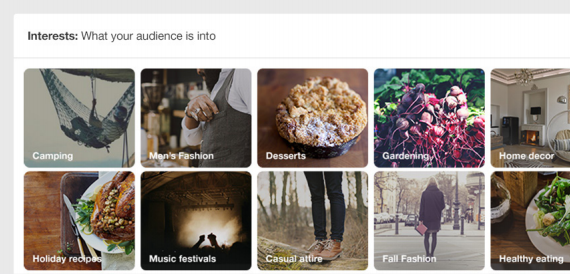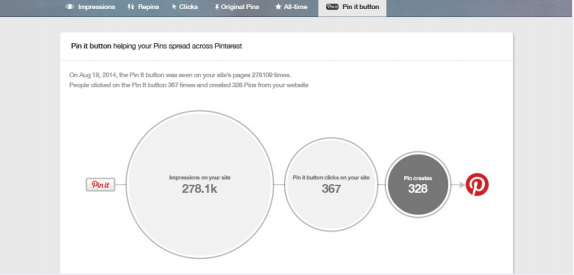
Not everything is fun and games. That’s a fact that been out in the universe since the beginning of time now.
Apart from keeping your Pinterest account up and alive with engaging content it is also essential to take a look at the analytics as well. A lot of us have sort of an allergic reaction when it comes to the word analytics. Little did you know that these analytics will help you gain perspective on how well or poorly your activities are performing.
Hootsuite has some in-depth knowledge to share when it comes to Pinterest Analytics and it’s importance to your business.
Types of Pinterest Analytics
For your brand’s Pinterest presence, there are specific areas you can measure to determine how your posts are performing and ultimately impacting your bottom line.
Pinterest’s analytics tool is divided into three areas: your Pinterest profile analytics (how the content of your actual Pinterest boards and pins are doing), your audience analytics (demographics) and your Pinterest website analytics (to see what content from your website is being pinned). While overlaps exist, there are different metrics to track for each of the analytics sections, as outlined below.
Pinterest profile analytics
- Impressions: the amount of times your Pin showed up in the Home Feed, search results, and category areas
- Repins: the number of times your Pin has been saved to somebody else’s board
- Clicks: the number of times someone clicks through to your website through a Pin)
- All-time stats: top Pins from the last 30 days, Pins with high repins, Pins with high clicks, your best Pins of all time, etc.
Pinterest audience analytics
Pinterest audience analytics includes information about the people who follow, connect, and engage with you on the platform, with audience insights such as:
- Country
- Gender
- Language
- Metro (city)
- Interests (other topics your audience is engaging with)
- Boards that contain a high number of matching Pins
- Other businesses your audience is interested in
Pinterest website analytics
To find out what content people like most from your website, Pinterest’s website analytics helps you track:
- Impressions
- Saves
- Clicks (linking back to your website)
- Date (to see activity from specific time periods)
As you can see, Pinterest Analytics is a comprehensive tool that offers you extensive options and areas to track both your Pinterest and website content. But why should you care?
Why Pinterest Analytics matter
You put a lot of blood, sweat, and many, many tears into the content you’re creating. You should know if it’s performing the way you want. Measuring Pinterest Analytics for business is a key step to ensuring that your time and resources are being used efficiently.
Our post How to Use Pinterest for Business discusses the importance of Pinterest Analytics and explains, “You can easily gather new data about your audience such as who they are, what they like, and what devices they use to Pin your content. Pinterest Analytics also shows how the Pin It button is performing on your website—and whether it’s directing referral traffic or not.”
Pinterest Analytics matter to you and your business strategy because they can:
- Help you identify your main competition (under the Audience section where you can see other brands that your audience is engaging with)
- Gather insights for your website (based on interaction with the Pin It button and content from your website being shared on Pinterest)
- See how much referral traffic you are gaining through Pinterest
- Understand how people are interacting with your Pins, better allowing you to create tailored content and engage your audience
- Help you get to know your audience better with detailed demographics
As chief marketing strategist of Idea Creative Marketing Whitney Roberts explains, “Analytics are the single biggest guiding factor to social media success.” It’s hard to argue with that. With this in mind, the next section will show you how to put this into action and track your Pinterest Analytics.
How to track Pinterest Analytics
First and foremost, you will need a Pinterest business account to use Pinterest Analytics. You can do this simply by going to www.analytics.pinterest.com and linking your existing Pinterest account.
Once in your business account homepage, you can access the analytics portion by clicking on “Track what works” or by clicking on the main Analytics button in the top left-hand corner.
After you click on Analytics, you arrive at your overview screen, which gives you an overview of how your content is performing. You’ll get a breakdown of average daily impressions, average daily viewers, average monthly viewers, and average monthly engaged viewers you reach. If you have linked your website, you will also be able to see your overall website metrics here.
At the bottom of your overview page, you will see information about your “Top Pin impressions” from the last 30 days. You will also be able to see Saves, Clicks, Likes, and Pin Type in this area.
If you want to see detailed information regarding the activity on your Pinterest profile, hover over the Analytics button at the top of your profile and select “Profile” from the drop-down menu.

Here, you can switch between tabs to see your Pins with the most impressions, repins, and clicks. In their guide Pinterest Analytics for Business, Pinterest offers the following tips for transferring what you are seeing in your Analytics results, to action.
What you’re seeing: “50 percent of my impressions are from people using smartphones and tablets.”
What you can do next: “I’ll work with my website developer to make sure that my website looks good and works on mobile devices.”
To access your audience analytics, go back to the “Analytics” button on the top left-hand corner and select “People you reach.” Here, you can click on the “Demographics” or “Interests” tabs to see who is looking at and interacting with your content.
As Pinterest explains, “Knowing where your audience is from, what languages they speak, and what gender they identify with can help you target your content. For instance, if you see that a large portion of your audience speaks French, you may have some new marketing opportunities in France.”
As seen below, you can also filter your audience information by different audiences (i.e. followers or all Pinterest users), as well as by the device they are accessing Pinterest on.
Besides demographics, the ‘People you reach’ area of Pinterest Analytics allows you to see what your audience is interested in. Click on the “Interests” tab to see:
- Interests: get more ideas about what kinds of content your audience responds to
- Boards: see how your audience organizes your content and considers your brand, which allows you to get ideas for your own organization and portrayal of brand
- Brands: find out what other products and services interest your audience to gain insight into what might be a popular move in the future
For this area, Pinterest offers the following suggestion on how to take action with your information.
What you’re seeing: “It looks like home decor, art, and travel are my followers’ key interests.
What you can do next: “I’m going to take more photos of my products in the home to reach Pinners who are interested in home decor.”

Finally, you can use Pinterest Analytics to see how your audience is interacting with your website content on Pinterest. Click on the “Analytics” button at the top left-hand corner again and select “Activity from (your website).” Here, you will see your metrics regarding the content people like the most from your website, what they are Pinning, what they are saving, and what they are clicking on. If you want information from a specific timeframe, you can easily do that here too by selecting a date range in your results.

If you aren’t seeing this, you may not have connected or confirmed your website. If you need help with this, Pinterest provides thorough guidelines on their Pinterest for Business page.
The ability for Pinterest to increase traffic to your website is something you don’t want to ignore, so Pinterest offers the following questions you can ask yourself to ensure you’re taking full advantage of this capability.
- Is it easy to Pin from my website? Make sure there’s a Pin It button on your site.
- Can people Pin from my mobile site? A whopping 75 percent of usage takes place on a mobile device, so make sure your site is optimized for this.
- Have I told people that I’m on Pinterest? Add a Follow button to your website so that your audience can easily find you on Pinterest.
- Am I staying active on Pinterest? Your followers get notified when you are active, which can help bring them back to your content.
Now that you know the basics of how to use Pinterest Analytics, there are some handy tools that can streamline the process even more.
Pinterest Analytics tools
Curalate
Curalate uses image-recognition algorithms to identify images your audience most wants to see, tracking the results as it goes. As their website explains, “Our image recognition technology surfaces which of your products are resonating on Pinterest, Instagram, Tumblr, and Facebook—so you can give your fans more of what they want.”
